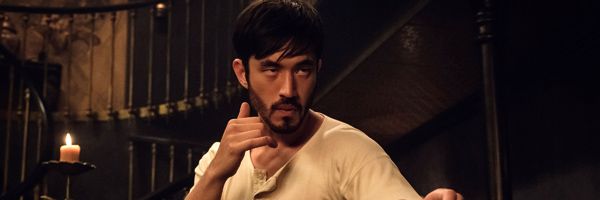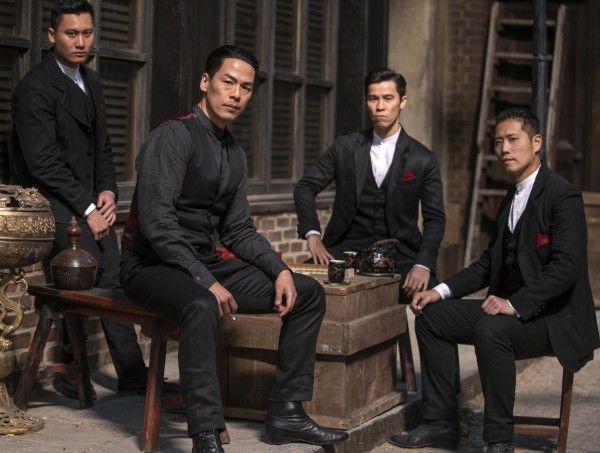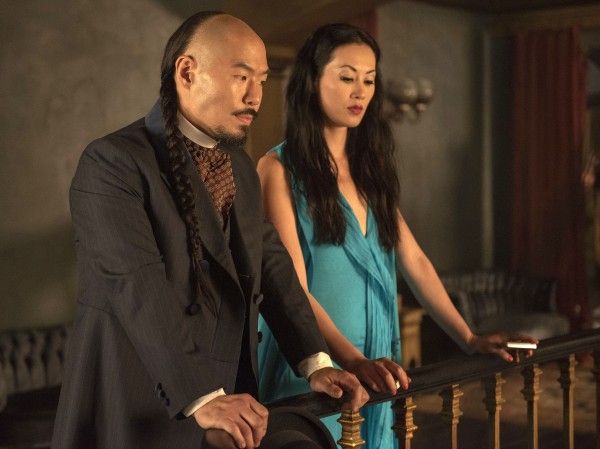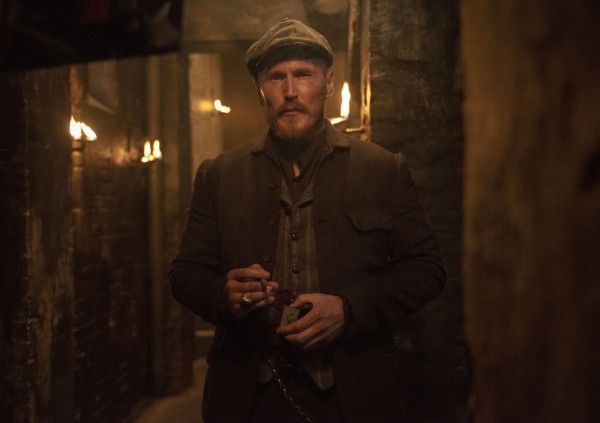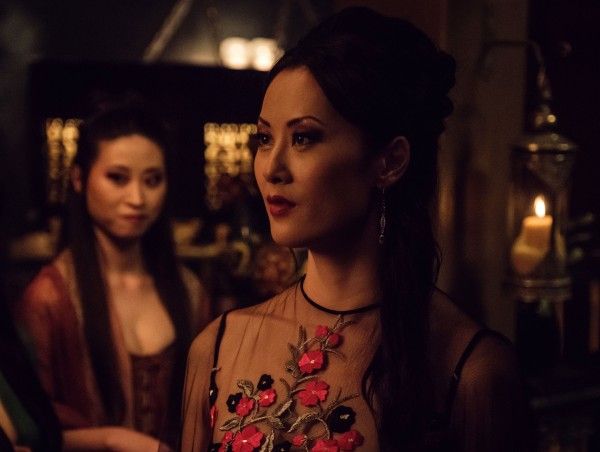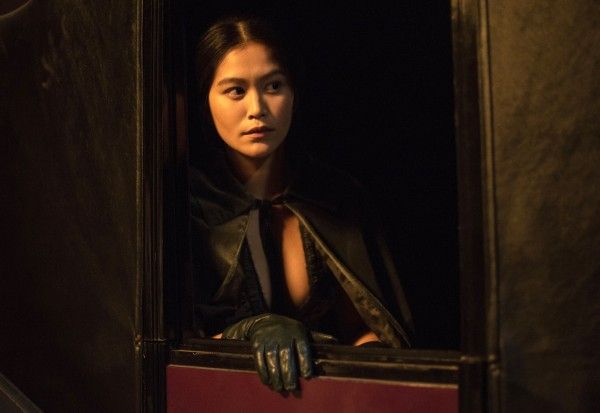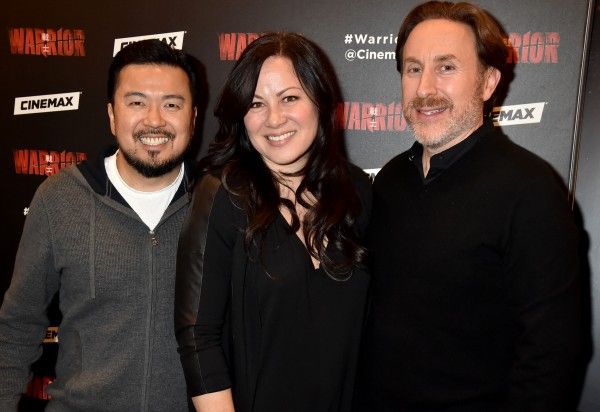The 10-episode gritty, action-packed drama series Warrior, which debuts on Cinemax on April 5th, is based on writings from martial arts legend Bruce Lee and is set during the brutal Tong Wars of San Francisco’s Chinatown in the second half of the 19th century. The story follows Ah Sahm (Andrew Koji), whose martial arts expertise will come in handy, as he realizes just how challenging leaving China behind for San Francisco can be, especially under mysterious circumstances that lead him to become a hatchet man for one of Chinatown’s most powerful Chinese organized crime families. The series also stars Kieran Bew, Olivia Cheng, Dianne Doan, Dean Jagger, Langley Kirkwood, Hoon Lee, Christian McKay, Joe Taslim, Jason Tobin, Joanna Vanderham, Tom Weston-Jones and Perry Yung.
Following a preview of the first episode of this new series, showrunner Jonathan Tropper (Banshee) and executive producers Justin Lin (Star Trek Beyond, Fast & Furious 6, Fast Five) and Shannon Lee (who’s also the daughter of Bruce Lee) spoke at a Q&A about the story’s 50-year development period, their own relationships with Bruce Lee’s work, why the time period and location are important, recreating 1878 San Francisco in South Africa, assembling this ensemble of actors, the incredible fight sequences, the role of the women in the story, pushing the envelope, and what they’re most excited about with the season.
Question: This TV series has a development story that spans nearly 50 years. Shannon, how did this finally go from Bruce Lee’s writings that were stored in the garage to what we will see now, with Warrior?
SHANNON LEE: Justin literally just called me, out of the blue. We knew each other. We had met, but we weren’t super close friends. He called me up and said, “Is this true? Does this exist?” And I said, “Yes.” He came over, a week later.
Justin, what’s your relationship with Bruce Lee’s work, and what made you want to do this?
JUSTIN LIN: I was a latch-key kid. I grew up in the ‘80s, so my relationship with Bruce Lee didn’t actually start off with Bruce Lee. I watched a lot of Saturday afternoon Kung Fu Theater, and it would have all of the fake Bruce Lees. The really good Bruce Lee movies didn’t make it onto local channels. So, my relationship with Bruce Lee started the first time I saw The Chinese Connection. My brother got this video tape and brought it home and was like, “This is the guy that they’re all trying to be.” I became obsessed with Bruce. Growing up Asian American, he had this gravitas and strength about him, and I’ve always wanted to explore that.
After Finishing The Game, (executive producer) Danielle Woodrow called me and said, “I read this thing about Kung Fu and Bruce Lee.” I remember watching Kung Fu, for the first time, and I was totally confused about why this white guy (David Carradine) was Chinese, and then I heard the backstory. So, when Danielle mentioned this story, I said, “I don’t know if it’s true or not, but I’ve heard about it.” Then, I called Shannon, and we got together. She brought over the eight-page treatment that Bruce Lee had typed on a typewriter. We read it, and there was something very magical about it. You could feel that, though it was almost 50 years old, it was so fresh and contemporary. That’s when we decided, “Let’s try to complete this. Let’s do this.” And it took us a little time, until we found Jonathan [Tropper] and Cinemax.
A lot of times, in film and TV, development projects die. You try, and if it dies, you just go for the next one. But, we weren’t going to let that happen with this. Also, Shannon trusted me with this material, and Danielle and I thought it was not only important to get it on screen, but with the right people. We met with a lot of people, and in that journey, it was very clear to us that we needed to embrace the essence of what Bruce Lee was trying to do, and part of that was finding someone to come play with us who could elevate the genre, and not just do something that’s in genre.
Jonathan, you have a previous relationship with Cinemax, having done Banshee with them, but don’t you also have a relationship with Bruce Lee’s work and martial arts?
JONATHAN TROPPER: I’ve been doing Chinese martial arts since about 5th or 6th grade, but I had never really seen any martial arts on TV. The first thing I saw was Way of the Dragon. There used to be this thing on Channel 5 in New York, where I grew up, called The Big Apple Movie, and I was just flipping through when they were showing what they called Return of the Dragon, but it was really Way of the Dragon, and I saw Bruce Lee, for the first time. I had been doing martial arts for a few years, at that point, but it didn’t look like that. I became obsessed with Bruce Lee, but there was nowhere to find it. I would watch The Big Apple Movie every weekend, and I’d see every horrible Kung Fu Theater movie that was made, waiting for Bruce Lee to come back, but he never did. And then, I went to Blockbuster, and they had one worn-out copy of Enter the Dragon, which I eventually got my hands on. I did martial arts through my entire childhood and into adulthood, and I always idolized Bruce Lee. There were not a lot of Jewish Kung Fu heroes. We’re very poorly represented, in that way. So, we had made the decision to finish up Banshee, and the guys at Cinemax knew I was a huge Bruce Lee fan, so they introduced me to Justin and Shannon, as they were talking about this, and I got really excited about being able to be the vessel to help them get that vision through the system and onto the screen at Cinemax.
Setting this story in San Francisco in 1878 brings a lot of social and political context that feels very current to today. Why did you want to set this in that time period and location?
LIN: For me, growing up, American history class doesn’t even have half a paragraph about the Chinese American experience, so I’ve always been fascinated by that. It was actually in the treatment from Bruce. When I read that, I felt that it was such an American story and that we had to do everything we could to bring it to life.
LEE: It was my father’s vision to portray an authentic Asian experience, so he set this in this time, in his treatment. He was really masterful at being able to touch on those significant moments, but it was Jonathan who really brought it all to life.
TROPPER: There wasn’t a lot of record-keeping done, and then there was also the big fire in San Francisco, a decade and a half later, that destroyed all of the records. Essentially, it became this story, coming in through the eyes of somebody who looks different and is different. You see, first hand, the institutionalized racism that’s woven into the fabric of a country that’s built by immigrants. It just became really fascinating to me. The big selling point, based on what the treatment had said, was how the Chinese, in 1882, became the only nationality ever to have a law on the books against their immigration, until now. Weirdly, it became incredibly timely, by the time we’ve gotten it to air. It’s also interesting just to look at the fact that, in over 100 years, the country really hasn’t changed.
To shoot this series, you recreated 1878 San Francisco in South Africa. How did you end up choosing that location?
LIN: I felt like it was important for us to really feel the texture of San Francisco. I’ve shot all over the world, so we went to Eastern Europe and the UK, but when we landed in Cape Town, it was very clear to us that there’s an amazing group there. Out of all of my movies, this is probably the biggest set that we’ve built. The level of pride and care that the crew has was important, in how we were going to be able to bring this to life. The next challenge was to hope that we could find people from around the world to move there.
You have a really great cast of international talent. How did you put this ensemble together?
LIN: It was really funny because we would look at the casting tapes and I kept saying, “I wish he was more like Jason Tobin,” to the point where finally I said, “I should just call Jason.” We tracked him down in Hong Kong.
TROPPER: Hoon Lee did four seasons of Banshee, and while we were casting all of this, it was always my intention, when I wrote the character of Wang Chao, that I was picturing Hoon playing him. That was something that was predetermined. That was one less person we had to look for, which was nice.
LIN: We did a wide cast and our casting director would show us everything, and then we’d go, “No, let’s keep going.” When I first got started, in 2002, you would have to go into the room and really fight for colorblind casting, but here we are, with a cast that’s gonna be all organically Asian and Asian American. The one thing that I’ve learned is that talent is out there. It’s about creating the opportunity. So, once we had it, we didn’t want to take that lightly. We wanted to go look, and make sure that we challenged everybody. Andrew Koji came in really late. It was hard because we wanted somebody that has soul and is a great actor, but who can also do his own action. He actually came in so late that, during the pilot, we had no stunt double. We were a tweaked ankle away from shutting down. And he’s not easy to double. He’s 6'2" and has a very unique physique. So, we felt it was important to make sure that process was not taken for granted. When we saw Andrew’s tape, he was just starting off and had only done a couple of things, and it turned out that he was Sung Kang’s stunt double on Fast & Furious 6. He had just started acting, and he came in and blew us away. With Joe Taslim, I said to Jonathan, “We have to bring Joe in.” There are perks of the job, and Joe is an amazing guy with great energy who goes all out. We’re very lucky for him to be a part of this amazing cast.
TROPPER: He’s barely in the pilot, but he plays a much bigger role, as we get into the season. I was a gigantic fan of The Raid. I think it’s The Godfather of modern martial arts movies. And I love that Justin had the ability to just pick the phone up and call him, and the next day, I was Skyping with him. It was a little challenging ‘cause Joe doesn’t need us. Joe’s got a busy career, and he didn’t wanna get locked in because there’s a lot of movies and other stuff for him to do. So, I told him, “Don’t worry, we’re gonna kill you, at some point, and let you go.” He’s super humble. That whole mean face disappears, the minute the camera is off, and he’s a teddy bear. And then, about three episodes in, we were standing on set and he came over to me and said, “I want to stay.” I was like, “Okay, Joe, you can stay.”
This show has a lot of swagger, particularly in the fight scenes, which is an homage to Bruce Lee. How did you want to infuse this with his spirit?
LEE: My father’s spirit is all over this show, and it’s in everybody involved with the show, which made it an amazing, magical experience. When it came to the action, we really took a beat from my father. He was the one to bring realism in martial arts to the movies. Prior to that, all of the action films in Hong Kong and Asia were these dramatic, swordplay, flying through the air Kung Fu movies, which he couldn’t stand, as a martial artist. He had a real love for wanting to portray, in an entertaining way, the reality of martial arts. So, for us, we really wanted to have there be a visceral realness to the action, and also a lot of entertainment. There are these little flares of swagger that are nods to my father, in the way that he moved and the things that he did. Jonathan was great with putting all of these little nods and things in.
TROPPER: Shannon would call me and go, “That’s one too many. Let’s take that one out.”
LIN: When I share this story with people, they’re like, “Oh, so the main character is who Bruce Lee wanted to play.” For me, when I was in the cutting room, it wasn’t just about Andrew. There will be a moment when I’m like, “Okay, there’s a little Bruce Lee there.” The actors, when they own their character, you just feel it. Joe might be the most extreme example of swagger, but with every character, when they find their own swagger, you feel like everybody became Bruce Lee.
How did you want to handle the women in this story?
TROPPER: Justin and Shannon want to subvert every trope, both from Kung Fu Theater and from the way things have been made, until this point. We didn’t want our main character, Ah Sahm, to be the plain, virtuous Kung Fu hero, who never drinks, smokes, fucks, gambles or screws up. We wanted everyone to be multi-dimensional and real. I think we’re way past the point where we want to see women in shows who need to be saved. Our three women – Penny Blake, who you only meet briefly in the pilot, Ah Toy and Mai Ling – are the power centers of where they are. The idea was that you have all of the Tong stuff going on, and you have sexist and racist America at its peak, but at the same time, you have these three women, who are very matter-of-factly defying all of the convention and building their power bases. For all intents and purposes, Mai Ling is controlling one of the most powerful Tongs. Ah Toy has built her own power base, as the most successful madam/vigilante in Chinatown. And Penny is a slower growth, but as the season progresses, you see that being the mayor isn’t all it’s cracked up to be, and she has other plans. You’ll watch these three women take control of their surroundings and become forces to be reckoned with.
Why was it important to you to make Leary such a multi-dimensional character, as well?
LIN: At the end of the day, it was important for us to create San Francisco, America, so it’s important to have different viewpoints. Leary is somebody who truly believes in what he says. As we were building the show, we felt like it was important that he wasn’t undercut, in any way.
This is a show with violence, sex and language. Why did you want to have that kind of freedom to tell this story with Cinemax?
LIN: I would go back to the original eight-page treatment that we all read. That transcended everything. Bruce Lee was trying to always be pushing the envelope, and trying to search and find a sense of honesty. For us, Cinemax has been a great partner because we can do anything we want. We’ve been able to really not shy away from things and just try. In the creative process, when art and commerce collide, instances like this are very rare, so you want to take advantage of it and hope you find a group of similar minds who want to go out there and just try.
LEE: And we want to show life. We want to be entertaining, but we also don’t want to shy away.
What are you most excited about, with this season?
TROPPER: For me, first and foremost, Ah Sahm’s arc in this season is not, at all, what people will expect. You’ll see him get skinned into a Tong, and he’s gonna become a hatchet man for the Tong, but that’s not why he came to America. That’s what he fell into because he, maybe unwisely, started a fight at immigration. Where he lands, towards the end of the season, is not remotely where anybody would expect him to be.
LEE: I’m really excited for the arc of the entirety of the show. Season 1 is just the beginning. We’ll hopefully get the opportunity to be able to play the long game here and really get into some extremely interesting stuff, which we already have planned. Hopefully, we’ll get to do that.
LIN: Whenever we feel like it’s going somewhere that you’ll expect, one of us will raise our hands and challenge that. This has been a great process, with everybody. It’s very rare to be able to have such a collaboration, where we can just call up each other and challenge each other, and I believe you’re gonna feel that with this show, from episode to episode. And just where you think you might know where it’s going, hopefully you won’t. That’s our goal, and that’s what we tried to achieve.
Warrior will debut on Cinemax in 2019.

